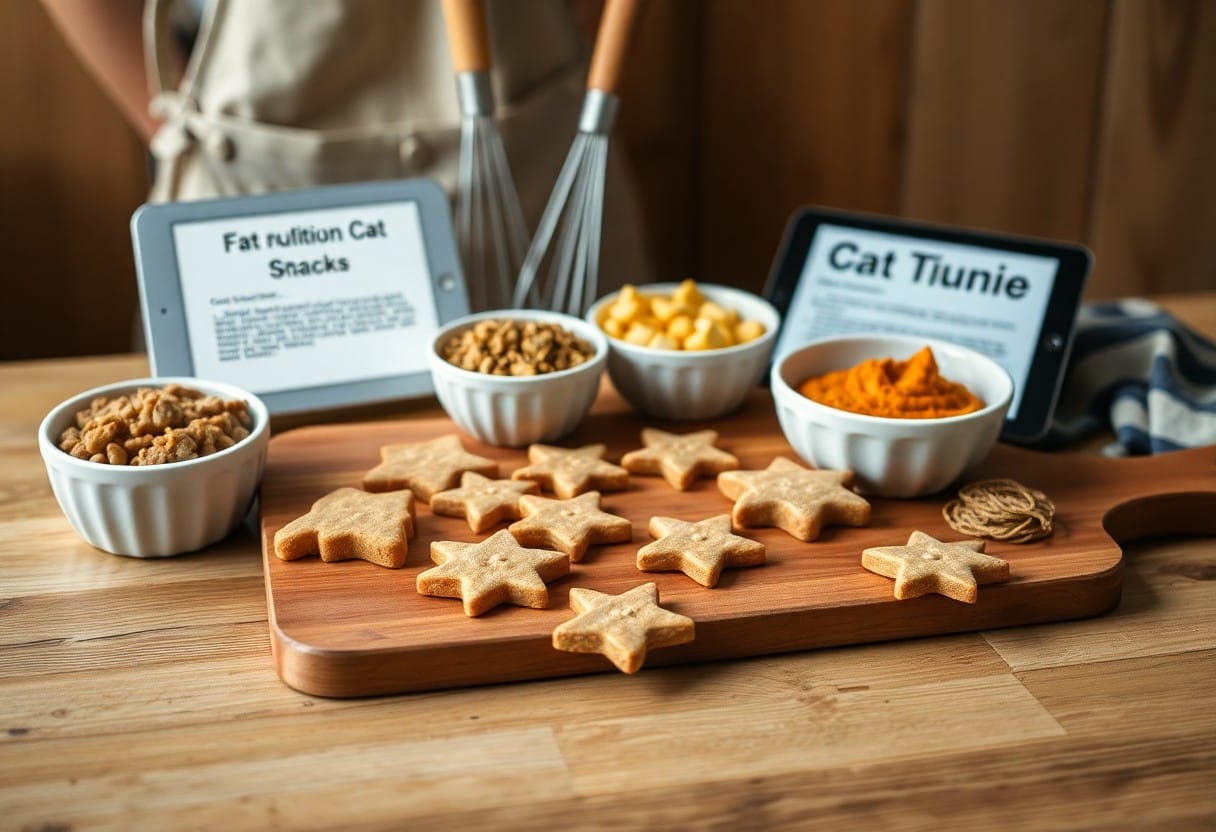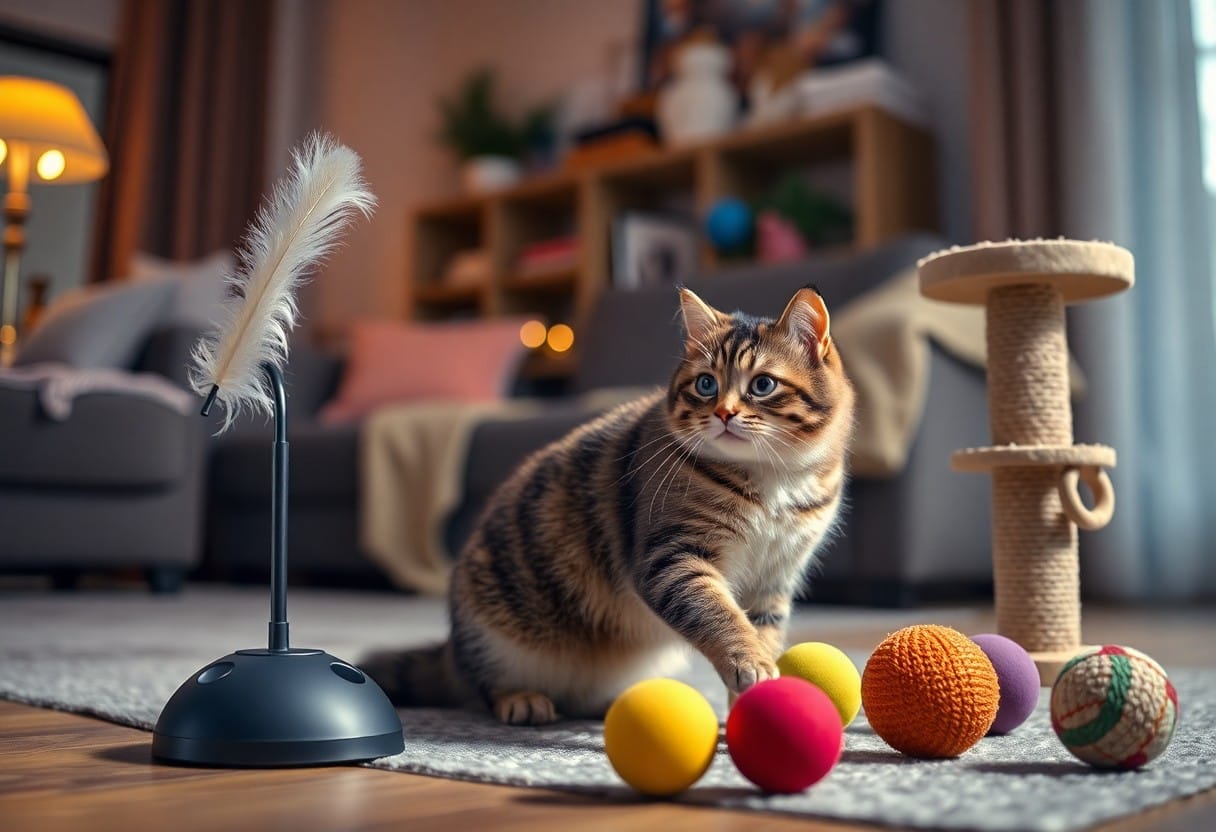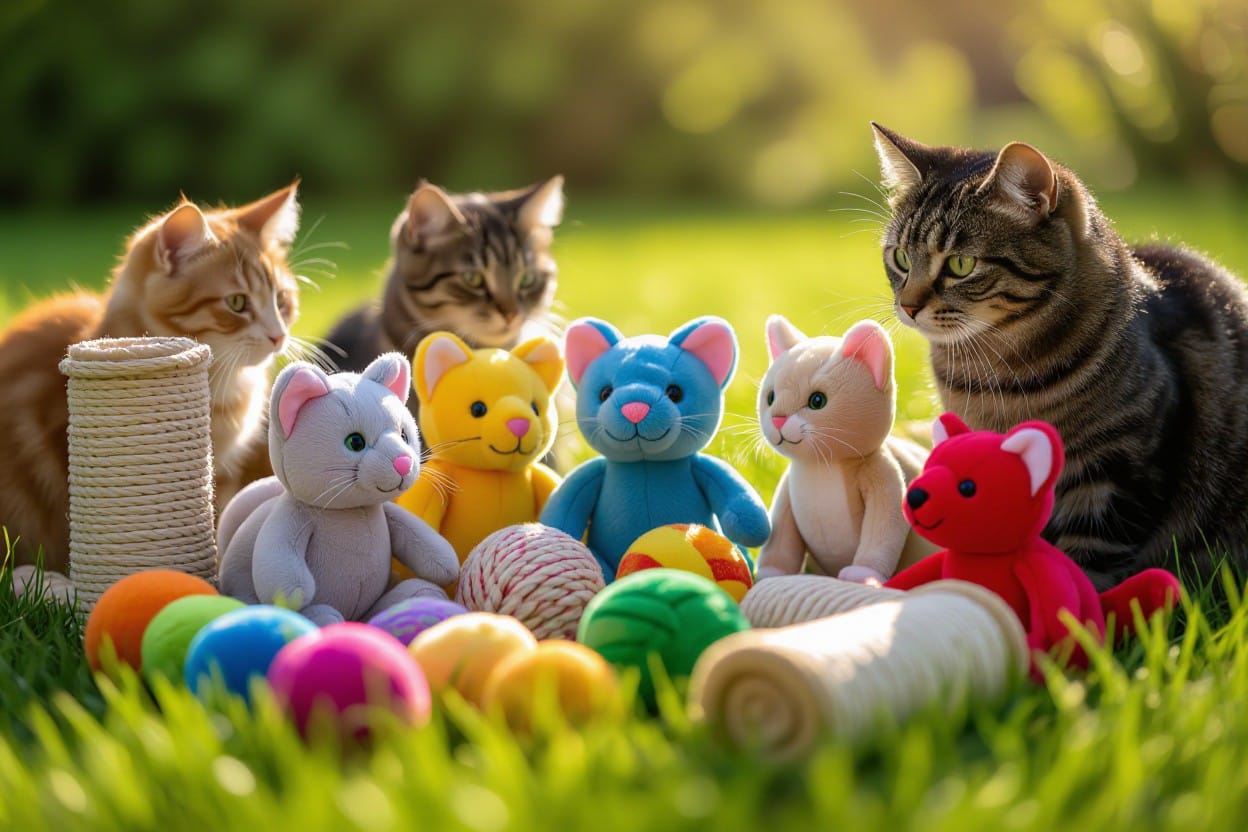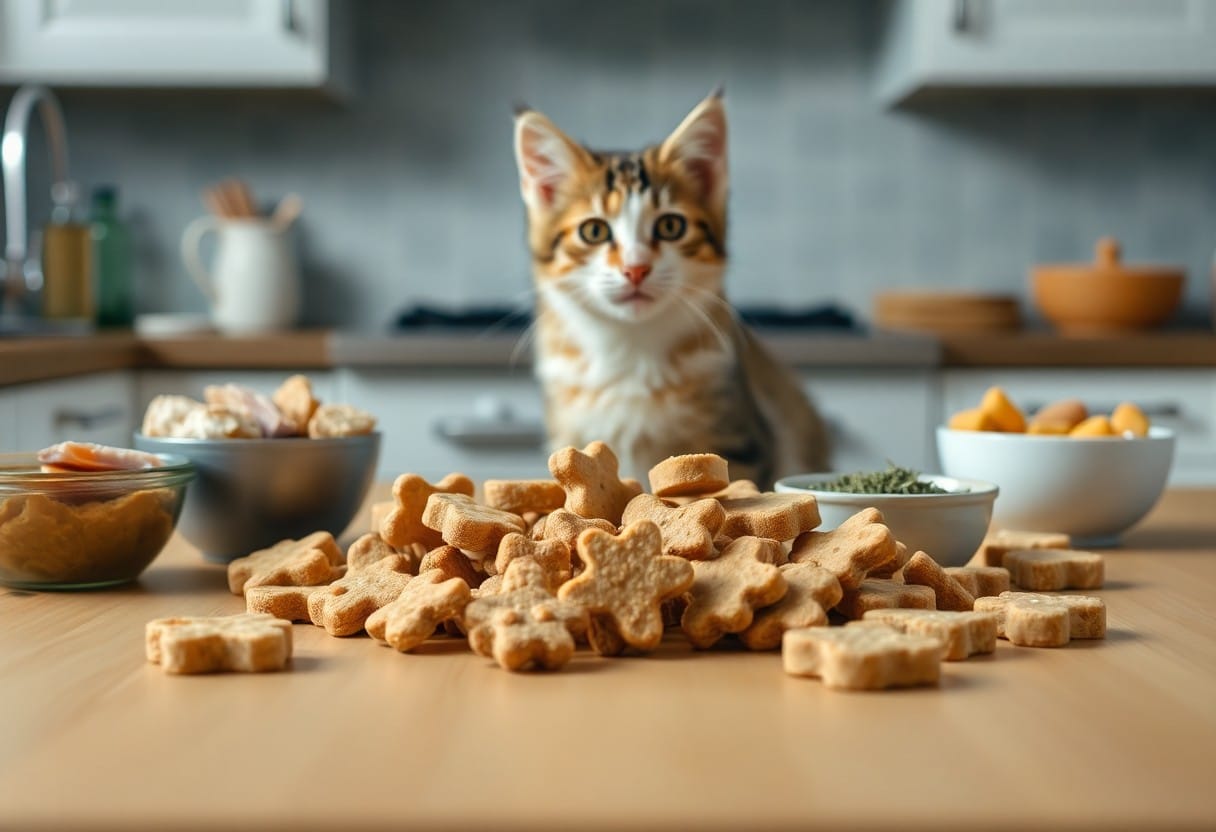Most pet owners strive to provide their feline friends with treats that not only satisfy their taste buds but also deliver crucial nutrients. By exploring homemade recipes, you can ensure that your cat enjoys treats free from harmful additives while also catering to their unique preferences. This blog post will guide you in discovering delicious and nutritious options for your cat, ultimately enhancing their well-being and happiness. You’ll find that combining flavor with nutrition doesn’t have to be a challenge—it’s a rewarding journey that can strengthen your bond with your beloved pet.

Key Takeaways:
- Exploring homemade cat treats allows pet owners to control ingredients, ensuring both taste and nutrition tailored to their cat’s needs.
- Utilizing common healthy ingredients such as fish, chicken, and whole grains can create flavorful recipes that appeal to feline palates.
- Incorporating supplements like vitamins and omega fatty acids can enhance the nutritional value of treats while still keeping them tasty.
The Science of Feline Nutrition Revolution
Understanding feline nutrition is pivotal for those who wish to concoct delectable and wholesome treats for their furry companions. As awareness grows about the importance of balanced diets, pet owners are exploring the intersection of flavor and health more than ever. The demand for premium, nutritionally sound cat treats has sparked a revolution in the pet food industry, urging you to rethink what goes into your pet’s snacks. With extensive research and an emphasis on high-quality ingredients, you can ensure that your homemade cat treats not only delight your cat’s palate but also support their overall well-being.
Decoding Essential Nutrients for Cats
Felines require a distinctive blend of nutrients to thrive, differentiating their dietary needs from those of dogs or humans. Essential amino acids like taurine and arginine are non-negotiable for heart health, eyesight, and overall metabolic functions. Furthermore, cats benefit from fats as a potent energy source, while vitamins and minerals play critical roles in sustaining their immune systems. By recognizing each nutrient’s role, you can skillfully design treats that cater to your cat’s specific health needs without compromising flavor.
The Role of Treats in a Balanced Diet
Treats serve more than just a reward; they can be integral to a balanced diet. In moderation, they provide an opportunity for careful dosage of important nutrients you want to supplement in your cat’s regimen. While commercial treats often lack nutritional value and may be laden with fillers, homemade options allow you to mix in beneficial ingredients. Utilizing foods like pumpkin for fiber or salmon for omega-3 fatty acids can enhance your cat’s diet, making it more well-rounded. You can also create treats that align with your veterinary advice, ensuring they contribute positively to your cat’s health, rather than detract from it.
Crafting Gourmet Treats: Ingredients that Dazzle
Elevating your cat’s snack game involves selecting ingredients that not only satisfy their palate but also contribute to their well-being. Think about incorporating flavors that excite—like chicken liver, tuna, or salmon—while also paying attention to texture. Using wholesome bases such as oat flour or even pumpkin puree enhances both flavor and nutrition, making your homemade treats a gourmet delight that your feline friend will finish in no time.
Superfoods that Cats Love
Integrating superfoods into your treats can transform snack time into a health boost. Ingredients like blueberries or spinach aren’t just trendy for humans; they pack antioxidants and vitamins beneficial for your cat. Another excellent option is chia seeds, rich in omega-3 fatty acids, which support a shiny coat and overall health.
Sneaking in Nutrients Without the Fuss
Making nutritious treats doesn’t have to be difficult. You can use simple methods to introduce extra vitamins and minerals into your recipes. This can be done through purees or powders that blend seamlessly with other ingredients, allowing you to maintain the treat’s taste and appeal while boosting its health benefits.
Utilizing nutrient-dense powders like spirulina or nutritional yeast can add an easy layer of nutrition. Spiralika, in particular, is a powerhouse of protein and vital amino acids that can enhance energy levels and your cat’s immune function. Just a teaspoon mixed into your cat snack dough provides a quick way to sneak in health benefits without altering the beloved flavors. Additionally, try pureeing vegetables like carrots or peas; they can be mixed into dough for added fiber without changing the taste. Your cat will enjoy the yummy snacks, and you’ll feel good about their health!
Proven Techniques for Flavorful Cat Treats
It’s all about technique when crafting irresistible cat treats that pack a nutritious punch. Experimenting with methods like baking or dehydrating can yield delightful results, enhancing both the aroma and texture that your feline friend will adore. Perfecting the baking temperature and time can create a crunchy texture, while low-temperature dehydration preserves crucial nutrients and flavors. Utilizing techniques like combining different cooking methods can also optimize the overall taste experience, ensuring that each bite keeps your cat coming back for more.
Baking vs. Dehydrating: What’s Best?
Baking treats may provide a familiar, crunchy texture that many cats enjoy, while dehydrating offers a chewy option that retains more nutritional value. Both methods have their merits, and choosing one often depends on your cat’s preferences. If your feline is particularly picky, consider offering treats using both techniques to assess which they favor. The beauty of home-preparing treats is the ability to customize size, shape, and flavor to meet your cat’s taste profile and dietary needs.
Flavor Pairings That Will Delight Your Feline
The right flavor combinations can transform simple ingredients into cat treat masterpieces. Ingredients such as tuna, chicken, and salmon pair wonderfully with cat-friendly herbs like catnip and parsley. Mixing textures, for instance, combining soft fish with crunchy pumpkin or oats, can also enhance the appeal. Don’t forget to think outside the box—add tiny bits of cheese or even a drizzle of bone broth for extra allure. This combination of distinct flavors and textures captivates your cat’s palate while also delivering a nutritious treat they’ll love.
Undeniably, it’s all about balance when devising flavor pairings. For example, using canned tuna blended with a spoonful of pumpkin creates a rich, moist treat packed with fiber and protein. Another enticing option is mixing boiled chicken with a hint of catnip, presenting a savory yet fragrant experience that’s hard to resist. Many cats gravitate towards the umami flavor profile, so incorporating ingredients that possess this taste can enhance your treats’ desirability. Don’t hesitate to experiment with varying combinations; discovering what excites your cat’s palate may lead to their new favorite snack.
Uncovering DIY Secrets from Feline Foodies
In the vibrant world of feline foodies, you’ll find an array of innovative DIY cat treat recipes inspired by the passionate pet parent community. Many of these recipes use common kitchen ingredients that are safe and healthy for your cat. With an emphasis on creativity, these cat lovers share their successes, from tuna-flavored biscuits to pumpkin-infused bites, ensuring that nutrition and taste are both front and center in their concoctions.
Innovative Recipes from the Pet Parent Community
Pet parents frequently experiment with fresh ingredients, unveiling recipes that combine meats, vegetables, and herbs into delectable cat treats. Online forums are filled with success stories of homemade salmon bites and chicken liver pâté, allowing fellow cat lovers to explore the endless possibilities available with just a few ingredients. These recipes not only cater to your cat’s taste buds but also promote overall health with each homemade morsel.
Experimenting with Textures and Flavors
To make cat treats even more appealing, experimenting with different textures and flavors can lead to delightful discoveries. Combining crunchy and chewy elements, such as blending freeze-dried meat with soft purees, creates tantalizing snacks for your feline. Your cat may prefer treats with enticing aromas, so don’t hesitate to experiment with various herbs like catnip or even a hint of cheese to stimulate their senses. Observing your pet’s reactions can provide valuable insights into their preferences, guiding your future culinary creations.
Elevating Treat Time: The Art of Presentation
Presentation is a vital aspect of treat time that can transform a mundane snack into a delightful experience for your feline friend. Incorporating creative serving techniques not only entices your cat but also enhances their sensory engagement, making them more excited to indulge in their nutritious morsels.
Creative Ways to Serve Treats
Introducing fun serving methods can elevate treat time significantly. Try using cute, themed dishes, like fish-shaped bowls or flower-patterned trays. You can also create a mini treasure hunt by hiding treats around your home, prompting your cat to use their natural hunting instincts, or serve them in a puzzle feeder for an interactive dining experience.
Engaging Your Cat’s Senses for Maximum Enjoyment
Engaging your cat’s senses can turn treat time into an adventure. Varying the way you present treats can enhance their enjoyment. Incorporating different textures, such as crunchy treats alongside creamy ones, can intrigue their taste buds while using scent to attract them can further pique their interest. A dash of catnip sprinkled on the treat or warming it slightly can amplify its attractiveness, creating a multi-sensory experience that your cat won’t resist.
Especially popular with cats, a variety of flavors combined with creative presentations—like layering treats in a clear container or using small, colorful shapes—invites exploration. For example, using a shallow dish surrounded by catnip can draw your cat in through sight and smell, while different textures invite paw-play. This multi-faceted approach ensures snack time is not just about nutrition but also provides mental stimulation, making each moment spent together even more extraordinary. Incorporating these elements transforms treat time into a cherished ritual that nurtures both body and bonding time.
Conclusion
With these considerations in mind, you can successfully discover secret recipes for cat treats that not only please your feline’s taste buds but also provide necessary nutrition. Experimenting with wholesome ingredients benefits both your cat and your pet-parenting skills. By keeping your cat’s dietary needs and preferences at the forefront, you ensure that each treat is a delightful blend of flavor and health, making snack time both enjoyable and nutritious for your furry friend.
FAQ
Q: Can you discover secret recipes for cat treats that are both tasty and nutritious?
A: Absolutely! There are numerous secret recipes that cater to both your cat’s taste buds and their nutritional needs. Ingredients such as chicken, salmon, and pumpkin are great bases for treats, providing proteins and important vitamins. By combining these with nutritious add-ons like flaxseed or catnip, you can create healthy snacks that your feline friend will love. Researching and experimenting with different combinations can lead you to uncover delightful recipes that meet both criteria.
Q: What are some common ingredients to include in homemade cat treats for optimal health?
A: When crafting homemade cat treats, it’s beneficial to use ingredients that contribute positively to your cat’s health. Proteins like chicken, fish, and turkey are excellent for muscle health. Additionally, consider incorporating ingredients like sweet potatoes for fiber, and oats for added energy. Herbs such as catnip can provide enrichment, while certain vitamins and minerals can be added through supplements if needed. Always ensure that the ingredients are safe for cats and avoid those known to be harmful, such as onions and garlic.
Q: How can I ensure that my homemade cat treats are safe and beneficial for my pet?
A: To ensure that your homemade cat treats are safe and beneficial, start by educating yourself about the dietary needs and restrictions of cats. It’s important to use high-quality ingredients that are fresh and properly sourced. Stick to tried-and-true recipes from reputable sources or consult with a veterinarian or pet nutritionist. Additionally, monitor your cat’s reaction to the treats to catch any adverse reactions early. Gradually introduce new recipes, and make sure to keep a balanced diet alongside these treats for optimal health.
















